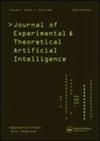Determining context of association rules by using machine learning
IF 1.7
4区 计算机科学
Q3 COMPUTER SCIENCE, ARTIFICIAL INTELLIGENCE
Journal of Experimental & Theoretical Artificial Intelligence
Pub Date : 2021-08-03
DOI:10.1080/0952813X.2021.1955980
引用次数: 0
Abstract
ABSTRACT Association rule mining is typically used to uncover the enthralling interdependencies between the set of variables and reveals the hidden pattern within the dataset. The associations are identified based on co-occurring variables with high frequencies. These associations can be positive (A→B) or negative (A→⌐B). The number of these association rules in larger databases are considerably higher which restricted the extraction of valuable insights from the dataset. Some rule pruning strategies are used to reduce the number of rules that can sometimes miss an important, or include an unimportant rule into the final rule set because of not considering the context of the rule. Context-based positive and negative association rule mining (CBPNARM) for the first time included context variable in the algorithms of association rule mining for selection/ de-selection of such rules. In CBPNARM, the selection of context variable and its range of values are done by the user/expert of the system which demands unwanted user interaction and may add some bias to the results. This paper proposes a method to automate the selection of context variable and selection of its value range. The context variable is chosen by using the diversity index and chi-square test, and the range of values for the context variable is set by using box plot analysis. The proposed method on top of it added conditional-probability increment ratio (CPIR) for further pruning uninteresting rules. Experiments show the system can select the context variable automatically and set the right range for the selected context variable. The performance of the proposed method is compared with CBPNARM and other state of the art methods.利用机器学习确定关联规则的上下文
关联规则挖掘通常用于揭示变量集之间引人入胜的相互依赖关系,并揭示数据集中隐藏的模式。这些关联是基于高频共存变量来确定的。这些关联可以是正的(A→B)或负的(A→__ B)。在大型数据库中,这些关联规则的数量相当多,这限制了从数据集中提取有价值的见解。一些规则修剪策略用于减少有时会因为没有考虑规则的上下文而错过重要规则或将不重要规则包含到最终规则集中的规则数量。基于上下文的正、负关联规则挖掘(CBPNARM)首次在关联规则挖掘算法中加入上下文变量,实现对正、负关联规则的选择和去选择。在CBPNARM中,上下文变量及其取值范围的选择由系统的用户/专家完成,这需要不必要的用户交互,并且可能会给结果增加一些偏差。本文提出了一种自动选择上下文变量及其取值范围的方法。使用多样性指数和卡方检验选择上下文变量,使用箱形图分析设置上下文变量的取值范围。该方法在此基础上增加了条件概率增量比(CPIR)来进一步修剪无兴趣规则。实验表明,该系统可以自动选择上下文变量,并为所选上下文变量设置合适的范围。将该方法的性能与CBPNARM和其他最先进的方法进行了比较。
本文章由计算机程序翻译,如有差异,请以英文原文为准。
求助全文
约1分钟内获得全文
求助全文
来源期刊
CiteScore
6.10
自引率
4.50%
发文量
89
审稿时长
>12 weeks
期刊介绍:
Journal of Experimental & Theoretical Artificial Intelligence (JETAI) is a world leading journal dedicated to publishing high quality, rigorously reviewed, original papers in artificial intelligence (AI) research.
The journal features work in all subfields of AI research and accepts both theoretical and applied research. Topics covered include, but are not limited to, the following:
• cognitive science
• games
• learning
• knowledge representation
• memory and neural system modelling
• perception
• problem-solving

 求助内容:
求助内容: 应助结果提醒方式:
应助结果提醒方式:


